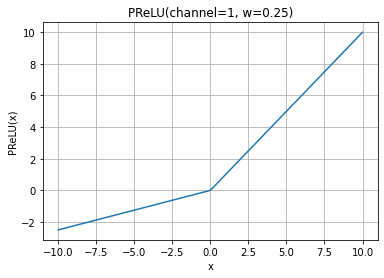mindspore.ops.prelu
- mindspore.ops.prelu(x, weight)[source]
Parametric Rectified Linear Unit activation function.
PReLU is described in the paper Delving Deep into Rectifiers: Surpassing Human-Level Performance on ImageNet Classification. Defined as follows:
where
Note
Scalar or 1-D Tensor is not supported on Ascend.
PReLU Activation Function Graph:

- Parameters
x (Tensor) – The input Tensor of the activation function. The data type is float16 or float32. The shape is
weight (Tensor) – Weight Tensor. The data type is float16 or float32. The weight can only be a Tensor, and the length is the same as the number of channels C of the input_x. On GPU devices, when the input is a scalar, the shape is
- Returns
Tensor, with the same shape and dtype as x. For detailed information, please refer to
mindspore.nn.PReLU.- Raises
TypeError – If dtype of x or weight is neither float16 nor float32.
TypeError – If the x or the weight is not a Tensor.
ValueError – If the x is a 0-D or 1-D Tensor on Ascend.
ValueError – If the weight is not a 1-D Tensor.
- Supported Platforms:
AscendGPUCPU
Examples
>>> import mindspore >>> import numpy as np >>> from mindspore import Tensor, ops >>> x = Tensor(np.arange(-6, 6).reshape((2, 3, 2)), mindspore.float32) >>> weight = Tensor(np.array([0.1, 0.6, -0.3]), mindspore.float32) >>> output = ops.prelu(x, weight) >>> print(output) [[[-0.60 -0.50] [-2.40 -1.80] [ 0.60 0.30]] [[ 0.00 1.00] [ 2.00 3.00] [ 4.0 5.00]]]
